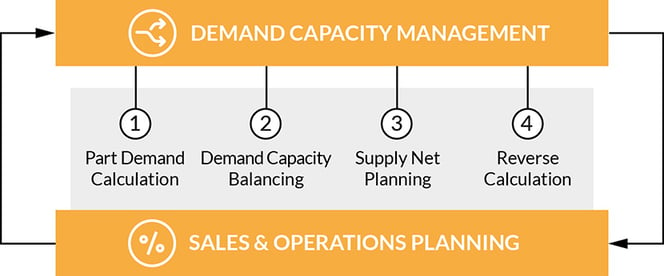4 Reasons, Why S&OP Should be a Solution for the Whole Supply Network
Robin Hornung - August 03, 2022

Manufacturing companies nowadays are in fact not single companies, but producing networks, which are operating at the heartbeat of the final assembly lines. Two key figures:
- The average automotive OEM is doing 30% of the value generation inhouse and 70% of the value generation in the supply network;
- 80% of the past year’s disruptions at OEMs had their origin in the supply networks.
Basically, everything in the network is connected, in globalized supply chains with various supply models, different lead times, different complexities, different needs for critical resources. BUT: our planning solutions often focus on the primary products only. Doesn’t it sound like a mismatch?
It does, and it is the one, which can be resolved with little extra work, but it does not require rocket science, it purely requires linking S&OP on primary product level and Demand Capacity Management on the part level using the BoM. This allows the synchronization of plans for primary products with the plans, forecasts, orders for parts. The four big benefits are obvious:
- an S&OP for an entire production network will result in consistent demand plans for the whole network, from OEM down to the low tiers of the supply net
- once consistent demand forecasts are in place, consistent capacity- and flexible volume plans can be done which helps to save cost, stabilize supply and support target-oriented flexibilities on volumes based on planned scenarios for the whole network.
- with volumes being transparent at any time for any knots of the network, reliable logistics plans can be generated to plan also for transportation resources at an early stage and in a reliable way, which again offers cost potentials and secures availability.
- S&OP in the short-term horizon and in the tactical horizon is about making adjustments and managing events. With a S&OP integrated with Demand Planning for the whole supply net, a coordinated reaction in case of events is done to align all partners
4 Key Aspects of an S&OP Solution for the whole network
1. Consider part capacities and deliveries when generating the production plans
With an S&OP solution, you can ensure stable supply levels by synchronizing your overall S&OP strategy with demand and capacity management. With these solutions, not only can you drill down to individual parts required for a product, but even to components of those parts, such as widely discussed microchips. This is critical because if S&OP is only focusing on the primary product and in-house processes, it only contributes to about 30% of the overall process. Instead, planning for the full supply network allows companies to synchronize their S&OP with the complete network
2. Identify and resolve mismatches in demand and capacity
In the past, companies gained value by using cheaper material sourced externally. Unfortunately, this has now created a battle for fewer and fewer resources to secure the capacity needed for a company’s supply network. A company that can make more reliable forecasts for their network will therefore be of a higher priority for suppliers. And again, the best way to improve the reliability of forecasts is to combine both S&OP and demand capacity management.
3. Create value in all planning horizons with a S&OP that is integrated with Demand & Capacity Planning
In the operational or short-term horizon, orders throughout the whole network are synchronized and it is guaranteed that volumes and supply have a perfect match.
In the tactical horizon, forecasts are generated based on scenarios for the whole supply network which allow to establish target-oriented flexibilities and give all network participants an early heads up of what is about to come.
In the more strategic horizons, an integrated S&OP forms the basis of the supplier contracts, which can either be done annually or in many cases for a whole product lifecycle, which is especially interesting if the suppliers are operating based on leased equipment which might even belong to the OEM. By synching S&OP and demand capacity management, companies can therefore plan with target-oriented flexibilities within certain threshold values and maximize their capacity with more accurate forecasts for their supply network.
4. Use Reverse Calculation of Part Constraints to Primary Product Constraints
When a company is given a limited number of parts, it can be difficult to prioritize what can and should be made. The best way to do this is with reverse calculations based on the capacity of a certain part you need to make a product. For example, if an original equipment manufacturer (OEM) knows the number of microchips they will receive for a year, they need to reverse calculate the number of products they can make with the available chips. These calculations can then help to prioritize production and inform business decisions. So, an automotive company can decide whether they want to make 10 expensive cars that require more electronics or 100 inexpensive cars that require fewer chips. To make these reverse calculations easier, the flexis S&OP solution is introducing “Rückrechnung”, an intelligent algorithm to support this line of decision making.
Plan for a Resilient Future with Integrated Demand Capacity Management
To remain competitive over the next 5-10 years, not only do companies need to develop a long-term S&OP strategy, but it needs to be synchronized with the supply net’s demand capacity management to holistically support the complete network. The flexis Demand Capacity Management solution is already integrated into the S&OP software to support this level of complex planning across an enterprise and on any time horizon. So, as production becomes increasingly complex, this type of end-to-end software solution can help companies to prevent lost revenue from mismatched demand and capacity.
Get more information
LATEST POSTS
- Understand Why Production Planning Needs Specialized Solutions
- Understand Circular Economy in The Manufacturing Industry
- How Can Industry 4.0 IT Integration Be Achieved Smoothly?
- The Significance of Order Sequencing in Discrete Manufacturing
- How to improve your Supply Chain Management: The Power of Control Towers




